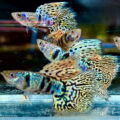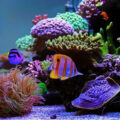When it comes to maintaining a healthy and thriving fish tank, many aquarium enthusiasts may overlook the potential benefits of adding snails to their aquatic ecosystem. While some may consider snails as pests, which is it?

Are They Good For Your Fish Tank?
Snails play a crucial role in transforming your fish tank into its own self-sustaining microcosm. In this article, we will explore the advantages of having snails in your fish tank, discuss the types of snails suitable for aquariums, and provide tips on how to introduce and manage snails in your tank.
The Role of Snails in a Fish Tank
Snails in a fish tank serve as detritivores, meaning they feed on decaying matter such as fish waste, uneaten food, and decaying plants. Their presence helps to maintain the overall water quality by preventing the accumulation of organic waste. By consuming this detritus, snails contribute to the natural waste management process, ensuring a cleaner and healthier environment for your fish.
See Also: What Do Freshwater Aquarium Snails Eat? (+Tips) for more information on feeding your pet freshwater snails.
Benefits of Having Snails in Your Fish Tank
- Maintaining ideal water conditions: Snails actively consume ammonia, nitrates, and other harmful substances, helping to control water parameters and reduce the risk of toxic buildup.
- Algae control: Snails are efficient algae eaters. They can help control the growth of algae in your fish tank and prevent it from taking over the aquarium ecosystem. This not only benefits the tank’s aesthetics but also ensures that the algae does not compete with other plants for resources.
- Enhancing the tank’s biodiversity: Snails contribute to the tank’s overall biodiversity. They add visual interest and provide a natural balance to the ecosystem, creating a healthier and more vibrant environment for your fish.

- Natural waste management: As mentioned earlier, snails actively consume decaying matter, reducing the accumulation of waste in the tank. This can help prevent any potential spikes in ammonia levels and maintain a cleaner living space for your fish.
- Providing a food source for fish: Snails reproduce and create a sustainable source of food for some fish species. This can be beneficial in aquariums where it may be challenging to provide varied food options for all the fish present.
Types of Snails Suitable for Fish Tanks
- Nerite Snails: These small, colorful snails are widely popular in aquariums. They are known for their algae-eating habits and can help control algae growth.
- Mystery Snails: With their vibrant shells and peaceful nature, mystery snails are a great addition to any fish tank. They are effective algae eaters and are relatively easy to care for.
- Malaysian Trumpet Snails: Malaysian trumpet snails are beneficial for aerating the substrate of the tank. They burrow into the substrate, preventing it from becoming compacted and allowing oxygen to reach the roots of live plants.
- Ramshorn Snails: Ramshorn snails are excellent scavengers, feeding on leftover fish food and detritus. They help maintain the cleanliness of the tank, reducing the risk of waste buildup.
- Pond Snails: Pond snails are hardy and reproduce quickly. While excessive population growth can be a concern, these snails are valuable in consuming decaying plant matter and other waste in the tank.
Rabbit Snails and Their Unique Benefits

Rabbit snails are a standout choice among freshwater snails due to their unique ability to eat algae and consume uneaten fish food, which helps maintain a clean and healthy tank. These snails not only enhance the visual appeal of your aquarium but also reduce waste buildup.
Rabbit snails are beneficial species that rarely overpopulate, unlike nuisance snails. Regularly monitoring snail eggs ensures that helpful snails like rabbit snails thrive without interference from pest snails, promoting a well-balanced and thriving freshwater tank.
How to Introduce Snails into Your Fish Tank
1. Establishing a compatible environment: Before adding snails, ensure that the water parameters and conditions in your tank are suitable for their needs. Snails thrive in freshwater aquariums with a stable pH, temperature, and appropriate substrate.
2. Selecting healthy snails: When purchasing snails, choose healthy specimens that are active and free from any signs of damage or illness.
3. Quarantining new snails: It’s advisable to quarantine new snails for a few weeks before introducing them to your main tank. This helps to prevent the introduction of any potential diseases or parasites into your established aquarium.
4. Acclimating snails to the tank: Before releasing them into the tank, allow the snails to adjust to the water temperature by floating the container they came in. This ensures a smoother transition and minimizes stress for the snails.

Potential Drawbacks of Having Snails in Your Fish Tank
- Overpopulation concerns: Some snail species have a high reproductive rate, leading to potential overpopulation in the tank. To avoid this, it’s essential to monitor the snail population and remove excess individuals as necessary.
See Also: What Should You Do With Mystery Snail Eggs and What to do with Unhatched Nerite Snail Eggs for tips on what to do when your snails reproduce.
- Potential damage to plants: While snails are generally harmless, certain species may feed on live plants, causing damage to their leaves. It’s important to choose snails that are plant-friendly, or provide alternative food sources to prevent excessive plant consumption.
- Snail-specific diseases: Snails can be susceptible to certain diseases and parasites. It’s crucial to maintain good water quality and regularly monitor for any signs of illness, providing appropriate treatment if necessary.
- Potential contribution to waste production: Although snails help with natural waste management, their presence can also contribute to the overall waste production in the tank. Regular water changes and monitoring of water parameters can help address this issue.
- Adjusting feeding habits: With the addition of snails, it’s important to adjust your fish’s feeding habits to prevent overfeeding. Snails alone cannot consume all the excess food, and overfeeding can lead to water quality issues.
Controlling Pest Snails in Freshwater Tanks
Aquarium snails are essential for maintaining a clean freshwater tank, but pest snails and nuisance snails can become problematic if not controlled. These unwanted species often lay snail eggs that lead to rapid overpopulation, disrupting the tank’s balance.
Freshwater snails like assassin snails are effective at controlling pest snails as they prey on other snails without harming your fish. Additionally, removing snail eggs and reducing uneaten fish food helps prevent the spread of nuisance snails. Ensuring a balanced population of snails can contribute to a healthier aquarium ecosystem.
See Also: What Freshwater Fish Eat Aquarium Snails? (19 Ideas) for fish species that are not only ornamental but can also help control your freshwater snail population.
Conclusion

In conclusion, snails can be beneficial additions to your fish tank. They help maintain ideal water conditions, control algae growth, enhance the tank’s biodiversity, provide a natural form of waste management, and even serve as a food source for some fish species.
By selecting appropriate snail species, monitoring the population, and providing proper care, you can enjoy the numerous advantages of having snails in your fish tank. Just remember to maintain a balance and be mindful of any potential drawbacks in order to create a thriving and harmonious aquatic ecosystem.











1 thought on “Are Snails Good For Your Fish Tank?”